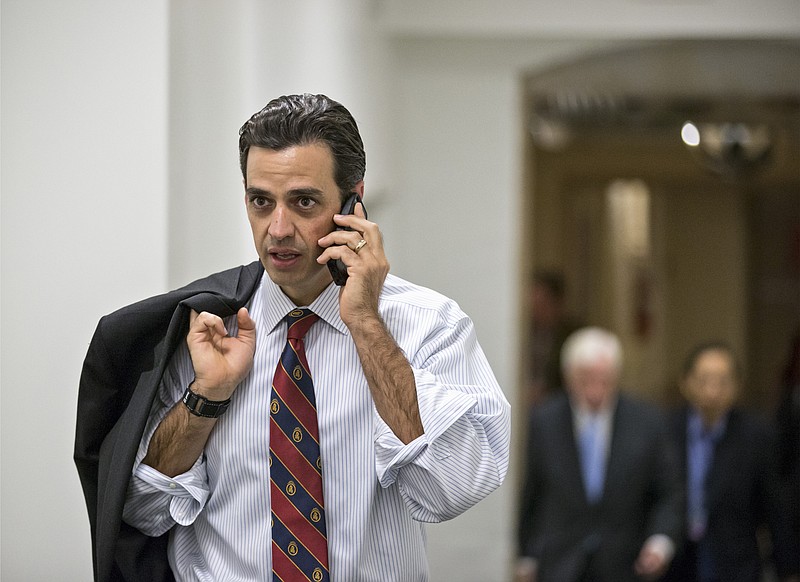Describing them as bold, U.S. Rep. Tom Graves said he supports EPA Administrator Scott Pruitt's plans to cut back much of his agency's operations.
According to an internal blueprint leaked to The Washington Post, the White House wants to slice the environmental agency's budget by about 25 percent, down to $6.1 billion. The plan also calls for a reduction in staffing from 15,000 to 12,000.
"I like the fact that Mr. Pruitt has come out of the gates early moving responsibility back to the states and also reducing the size of the EPA," Graves said during a teleconference with Northwest Georgia voters Wednesday night.
The Republican from Ranger, Ga., echoed beliefs from party leaders that the EPA needs to be smaller and that environmental issues generally should not be centered in Washington, D.C.
"If you're back in the states," he said, "then you have the local general assemblies or elected officials there that are closer to the impact. The further any of these agencies are away from the people, the harder it is to change them in a positive way."
According to the plan leaked to The Washington Post, President Donald Trump's administration wants state-level environmental groups to take the lead on these issues. In Georgia, that would be the Environmental Protection Division. Much of the EPA's money already goes to states in the form of grants, which would be cut by 30 percent.
The budget plans need to be approved through the congressional appropriations process. On Tuesday, Pruitt told the E&E News, a publication for energy and environmental professionals, that the proposals are still up in the air.
"I am concerned about the grants that have been targeted, especially around water infrastructure, and those very important state revolving funds," he said.
Graves' teleconference came a week after he and other congressmen were in recess, a time period in which liberal activists pushed for public town hall meetings with their representatives, hoping to press elected officials on whether they support Trump's policies.
Graves did not attend such a meeting in his region. His spokesman said he already was too committed with events during recess week. But he held the teleconference, a common practice for him, saying the event reaches more people than a public meeting would. On Wednesday night, Graves told listeners that 7,000 people were on the phone with him.
"It was not a substitute for an in-person town hall," said Patrick Gallagher, one of the people in Whitfield County who pushed for a large meeting with the congressman last week. "And it is telling that Graves didn't advertise last night on his website, Twitter or Facebook. He's very content to dodge his constituents."
Graves ran polls during the teleconference. Forty-six percent of respondents said they wanted lower taxes, while another 38 percent said they wanted a simpler tax code. In another poll, 60 percent said they wanted Congress to repeal and replace the Affordable Care Act, while the other 40 percent was split down the middle on whether to keep the policy the way it is or completely cut it.
In a third poll, 51 percent of people said they wanted to build a wall along the Mexico border, no matter the cost. Another 21 percent said the government should build a wall only if it's affordable, while 25 percent said they do not want a wall going up at all.
Graves supports Trump's plan to build a wall, telling listeners Wednesday night that he wants an immigration plan that vets more people coming into the country illegally. He told listeners that the Trump administration projects the cost of the wall to be $4-$6 billion.
In fact, the Trump administration estimates the cost to be $10-$12 billion. Congressional leaders Paul Ryan and Mitch McConnell have estimated the cost to be up to $15 billion. And an internal U.S. Department of Homeland Security report projected the cost at $21.6 billion.
"The one thing we have in the White House is a builder," Graves said. "And I know this is certainly an important project for him, not because of politics but because of national security. As long as we keep our focus on national security, I think we will always be in a better place."
Graves said there are some good models for strong border barriers. In San Diego, for example, a 46-mile wall runs along the entry from Mexico. And a 13-mile stretch along the Tijuana corridor actually features two fences.
Since the late 1980s, when the government erected the wall out of pieces of military helicopter landing mats, illegal immigration in San Diego has plummeted. According to U.S. Customs and Border Protection, agents apprehended about 630,000 illegal immigrants in 1986. By 2016, the number of apprehensions dropped to 32,000 - a 94 percent decrease.
However, immigration experts argue that other factors caused immigration to fall during the last 30 years, such as a weaker U.S. economy. Across the country, even in areas without a wall, illegal immigration dropped, according to U.S. Customs and Border Patrol.
In 1986, agents apprehended 1.7 million immigrants who tried to enter the U.S. illegally. In 2016, the number was down to 416,000 - a 75 percent drop.
Contact staff writer Tyler Jett at 423-757-6476 or tjett@timesfreepress.com. Follow him on Twitter @LetsJett.
